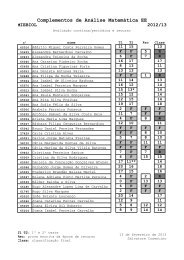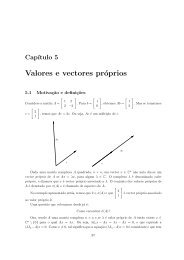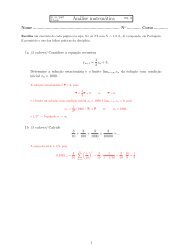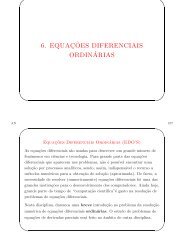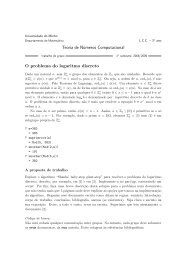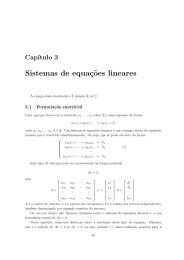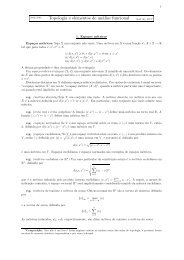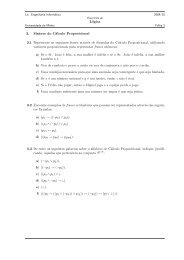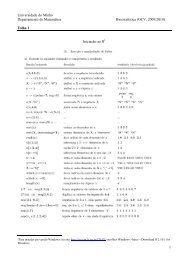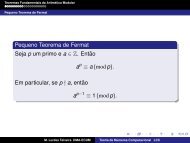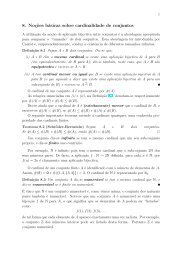My title - Departamento de Matemática da Universidade do Minho
My title - Departamento de Matemática da Universidade do Minho
My title - Departamento de Matemática da Universidade do Minho
Create successful ePaper yourself
Turn your PDF publications into a flip-book with our unique Google optimized e-Paper software.
4<br />
NÚMEROS E DINÂMICA 22<br />
or, equivalently, that x 1 is the unique integer between 0 and 9 such that<br />
10 · r 0 = x 1 · q + r 1<br />
where, again, the rest r 1 is a non-negative integer 0 ≤ r 1 < q. And so on. Hence, the digits of the<br />
<strong>de</strong>cimal expansion of p/q are iteratively <strong>de</strong>termined by<br />
10 · r n−1 = x n · q + r n where 0 ≤ r n < q<br />
Theorem. The rational numbers are precisely those real numbers whose representation in base<br />
10 (or any other base d ≥ 2) is repeating/recurring.<br />
Meanwhile, there exists irrational numbers!<br />
Exercícios.<br />
• Show that the <strong>de</strong>cimal representation of a rational terminates iff the <strong>de</strong>nominator is 2 a 5 b .<br />
• Write 1/3 in base 2, and 2/3 in base 3 and 7.<br />
• Show that the <strong>de</strong>cimal (or any other base) representation of a rational number is repeating<br />
(observe that the possibilities for the rests r n are finite).<br />
• Show the converse: a repeating <strong>de</strong>cimal represents a rational number (compute the sum of<br />
the series).<br />
• Give examples of non-repeating <strong>de</strong>cimal expansions (see [HW59], section 9.4).<br />
• Prove that Euler’s number<br />
e =<br />
∞∑<br />
n=0<br />
is irrational (Fourier’s i<strong>de</strong>a: assume that e = p/q for some positive integers p/q, and <strong>de</strong>duce<br />
that x = q! (e − ∑ q<br />
n=0 1/n!) is then an integer. Estimate the series x = ∑ ∞<br />
n=q+1<br />
q!/n! and<br />
prove that 0 < x < 1).<br />
Multiplicação ×d. Seja d ≥ 2 um inteiro. A transformação F : R → R que envia ca<strong>da</strong> número x<br />
no seu múltiplo d · x tem uma dinâmica trivial. As coisas ficam mais interessantes se consi<strong>de</strong>ramos<br />
os números módulo os inteiros, e <strong>de</strong>finimos a multiplicação por d como sen<strong>do</strong> a transformação <strong>do</strong><br />
círculo ×d : R/Z → R/Z que envia<br />
x + Z ↦→ d · x + Z<br />
Se x = 0.x 1 x 2 x 3 . . . é a representação <strong>de</strong> x ∈ R/Z ≃ [0, 1) na base d, então a transformação ×d<br />
envia<br />
0.x 1 x 2 x 3 . . . ↦→ 0.x 2 x 3 x 4 . . .<br />
Exercícios.<br />
• Verifique que ×d é contínua.<br />
• Determine a cardinali<strong>da</strong><strong>de</strong> <strong>da</strong> imagem inversa <strong>de</strong> um ponto arbitrário <strong>de</strong> R/Z.<br />
1<br />
n!<br />
• Determine os pontos periódicos e pré-periódicos <strong>de</strong> ×d.



